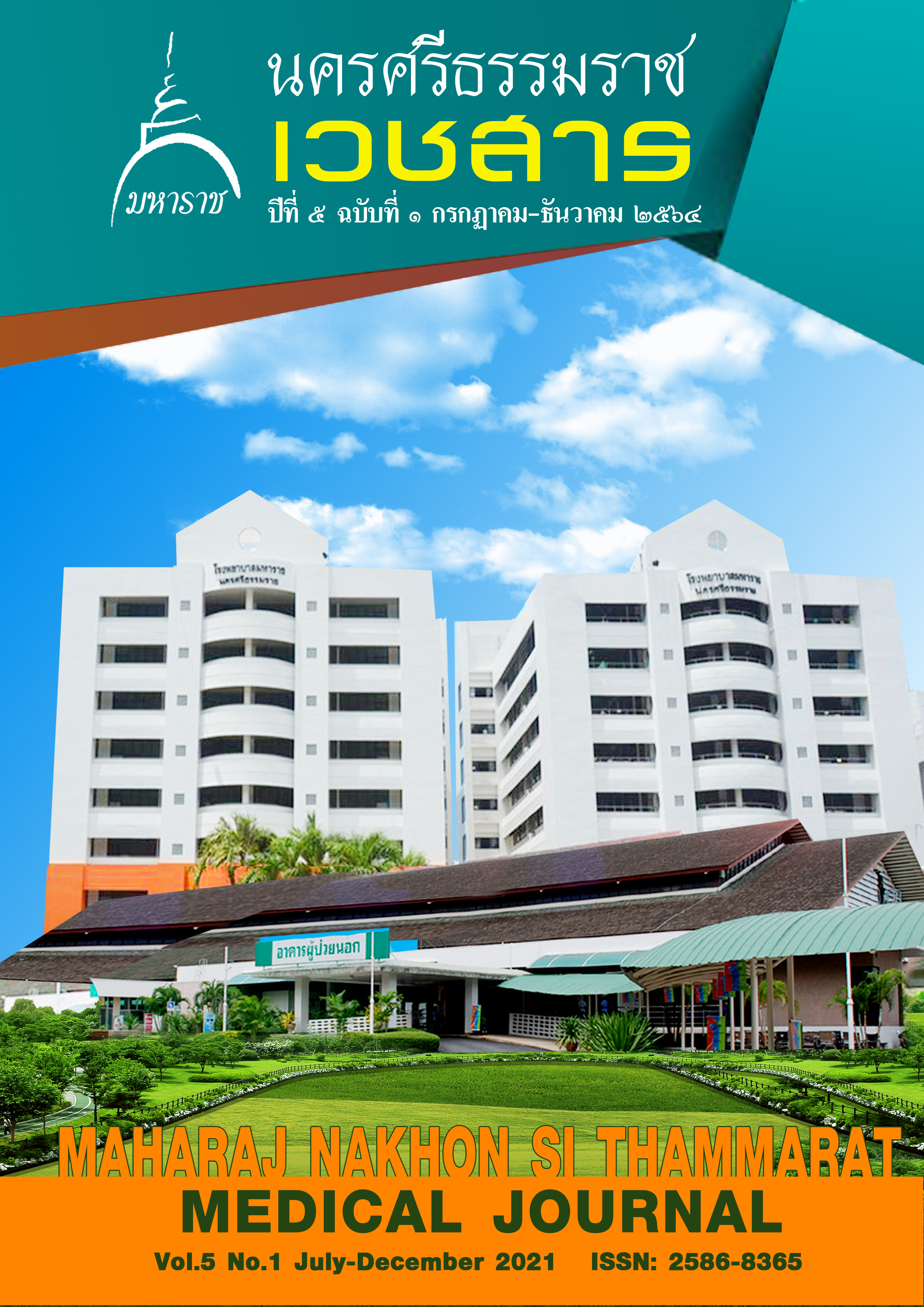การศึกษาปัจจัยที่มีผลให้ผู้ป่วยที่นอนรักษาในห้องสังเกตอาการระยะสั้น (Observe Unit: OU) ของแผนกเวชศาสตร์ฉุกเฉิน โรงพยาบาลมหาราชนครศรีธรรมราช ต้องย้ายไปรักษาเป็นผู้ป่วยใน (Inpatient Department: IPD ) แผนกต่าง ๆ
คำสำคัญ:
ห้องสังเกตอาการระยะสั้น, ระดับความรุนแรงของผู้ป่วยบทคัดย่อ
บทนำ: ห้องสังเกตอาการระยะสั้นเหมาะสำหรับผู้ป่วยที่มาตรวจที่ห้องฉุกเฉิน ต้องการระยะเวลาสั้นๆ ในการรักษาควรเป็นกลุ่มโรคหรืออาการที่ไม่รุนแรง จำหน่ายกลับบ้านได้ภายใน 24 ชั่วโมง แต่พบว่าผู้ป่วยบางรายอาการแย่ลงจนต้องย้ายไปแผนกผู้ป่วยใน และมีภาวะแทรกซ้อนที่รุนแรงตามมา
วัตถุประสงค์: เพื่อศึกษาปัจจัยที่มีผลให้ผู้ป่วยในห้องสังเกตอาการระยะสั้นของแผนกเวชศาสตร์ฉุกเฉิน ต้องย้ายไปรักษาเป็นผู้ป่วยในแผนกต่าง ๆ
วัสดุและวิธีการศึกษา: ศึกษาย้อนหลังเชิงพรรณนา โดยทบทวนเวชระเบียนผู้ป่วยที่เข้ารักษาในห้องสังเกตอาการระยะสั้น(OU) แล้วต้องย้ายไปเป็นผู้ป่วยใน(IPD) ตั้งแต่วันที่ 19 เมษายน พ.ศ.2562 ถึง 19 เมษายน พ.ศ. 2563
ผลการศึกษา: ผู้ป่วยจำนวนทั้งสิ้น 1,086 คน มี 196 คน (18%) ต้องย้ายเข้ารับการรักษาที่ IPD ปัจจัยที่สัมพันธ์กับการที่ผู้ป่วยต้องย้ายแผนก คือระดับความรุนแรงจากการ triage level emergency และ urgency กลุ่มอาการไข้ไม่ทราบสาเหตุ อาการปวดท้องที่ไม่ทราบสาเหตุ และกระเพาะอาหารอักเสบ (p=0.001, 0.022, 0.043 และ 0.021 ตามลำดับ) ส่วนโรคหรืออาการที่เป็นสาเหตุของการย้ายมากที่สุดได้แก่กลุ่มอาการไข้ไม่ทราบสาเหตุ (30.1%), กลุ่มอาการถ่ายเหลวและสำไส้อักเสบ (18.3%)และอาการปวดท้องที่ไม่ทราบสาเหตุ (13.7%) ตามลำดับ
สรุป: ระดับความรุนแรงของการคัดแยกผู้ป่วยแรกรับที่ห้องฉุกเฉิน (triage level) ในระดับ emergency และurgency อาการไข้ไม่ทราบสาเหตุ อาการปวดท้องที่ไม่ทราบสาเหตุ และกระเพาะอาหารอักเสบ เป็นปัจจัยที่สัมพันธ์กับการที่ผู้ป่วยต้องย้ายแผนก
เอกสารอ้างอิง
2. Gururaj VJ, Allen JE, Russo RM. Short stay in an outpatient department. An alternative to hospitalization. Am J Dis Child. 1972;123:128-32.
3. Yealy DM, De Hart DA, Ellis G, et al. A survey of observation units in the United States. Am J Emerg Med. 1989;7:576-80.
4. Wiler JL, Ginde AA. 440: National Study of Emergency Department Observation Services. Ann Emerg Med. 2010;56:S142.
5. Mace SE, Graff L, Mikhail M, et al. A national survey of observation units in the United States. Am J Emerg Med. 2003;21:529-33.
6. Jelinek GA, Galvin GM. Observation wards in Australian hospitals. Med J Aust. 1989;151:80, 2-3.
7. Aggarwal P, Wali JP, Ranganathan S, et al. Utility of an observation unit in the emergency department of a tertiary care hospital in India. Eur J Emerg Med. 1995;2:1-5.
8. Lateef F, Anantharaman V. The short-stay emergency observation ward is here to stay. Am J Emerg Med. 2000;18:629-34.
9. Liu Y, Zhang B, Fu W, et al. A preliminaryepidemiological study of the patient population visiting an urban ED in the Republic of China. Am J Emerg Med. 1994;12:247-9.
10. Carpentier F, Guignier M, Eytan VL. [Short emergency hospitalization]. Therapie. 2001;56:151-5.
11. Portela MC, Schramm JM, Pepe VL, et al. [Algorithm for establishing hospital admittance data based on the hospital information system in the Brazilian Unified Health System]. Cad Saude Publica. 1997;13:771-4.
12. Goodacre SW. Role of the short stay observation ward in accident and emergency departments in the United Kingdom. J Accid Emerg Med. 1998;15:26-30.
13. Gouin S, Macarthur C, Parkin PC, et al. Effect of a pediatric observation unit on the rate of hospitalization for asthma. Ann Emerg Med. 1997;29:218-22.
14. Hadden DS, Dearden CH, Rocke LG. Short stay observation patients: general wards are inappropriate. J Accid Emerg Med. 1996;13:163-5.
15. Observatinal unit. ใน นายแพทย์ชาติชาย คล้ายสุบรรณ ,บรรณาธิการ. คู่มือแนวทางการจัดบริการห้องฉุกเฉิน. กรุงเทพมหานคร: สามชัย 2017. 2561. หน้า 68-69.
16. Hostetler B, Leikin JB, Timmons JA, et al. Patterns of use of an emergency department-based observation unit. Am J Ther. 2002;9:499-502.
17. Ross MA, Compton S, Richardson D, et al. The use and effectiveness of an emergency department observation unit for elderly patients. Ann Emerg Med. 2003;41:668-77.
18. Ross MA, Davis B, Dresselhouse A. The role of an emergency department observation unit in a clinical pathway for atrial fibrillation. Crit Pathw Cardiol. 2004;3:8-12.
19. Medicare Benefit Policy Manual. Chapter 6—Hospital ServicesCovered Under PartB.2013.http://www.cms.gov/RegulationsandGuidance/Guidance/Manuals/downloads/bp102c06.pdf. Accessed 17 Oct 2013.
20. Mace SE, Graff L, Mikhail M, et al. A national survey of observation units in the United States. Am J Emerg Med. 2003;21:529-33.
21. Hostetler B, Leikin JB, Timmons JA, et al. Patterns of use of an emergency department-based observation unit. Am J Ther. 2002;9:499-502.
22. Ross MA, Compton S, Richardson D, et al. The use and effectiveness of an emergency department observation unit for elderly patients. Ann Emerg Med. 2003;41:668-77.
23. Brillman J, Mathers-Dunbar L, Graff L, Joseph T, Leikin JB, Schultz C, et al. Management of observation units. American College of Emergency Physicians.Ann Emerg Med. 1995 Jun;25(6):823-30
24. Mace SE. Resuscitations in an observation unit. J Qual Clin Pract. 1999;19:155-64.
25. Jones PF. Active observation in management of acute abdominal pain in childhood. BrMed J. 1976;2:551-3.
26. Graff L, Radford MJ, Werne C. Probability of appendicitis before and after observation. Ann Emerg Med. 1991;20:503-7.
ดาวน์โหลด
เผยแพร่แล้ว
รูปแบบการอ้างอิง
ฉบับ
ประเภทบทความ
สัญญาอนุญาต
เนื้อหาและข้อมูลในบทความที่ลงตีพิมพ์ในมหาราชนครศรีธรรมราชเวชสาร ถือเป็นข้อคิดเห็นและความรับผิดชอบของผู้เขียนบทความโดยตรงซึ่งกองบรรณาธิการวารสาร ไม่จำเป็นต้องเห็นด้วย หรือร่วมรับผิดชอบใด ๆ
บทความ ข้อมูล เนื้อหา รูปภาพ ฯลฯ ที่ได้รับการตีพิมพ์ในมหาราชนครศรีธรรมราชเวชสาร ถือเป็นลิขสิทธิ์ของมหาราชนครศรีธรรมราชเวชสาร หากบุคคลหรือหน่วยงานใดต้องการนำทั้งหมดหรือส่วนหนึ่งส่วนใดไปเผยแพร่ต่อหรือเพื่อกระทำการใด จะต้องได้รับอนุญาตเป็นลายลักษณ์อักษรจากวารสารมหาราชนครศรีธรรมราชเวชสาร ก่อนเท่านั้น



